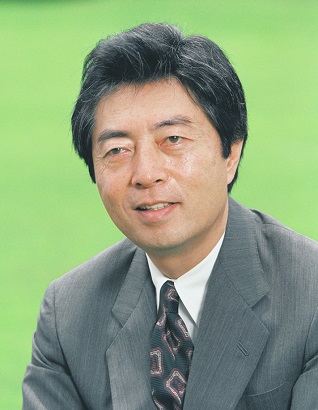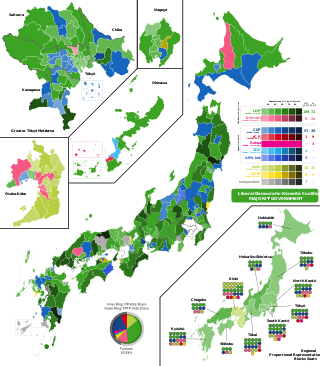
Kakuei Tanaka was a Japanese politician who served in the House of Representatives from 1947 to 1990, and was Prime Minister of Japan from 1972 to 1974.

Morihiro Hosokawa is a Japanese politician who was Prime Minister of Japan from 1993 to 1994, leading a coalition government which was the first non-Liberal Democratic Party (LDP) government of Japan since 1955. After a funding scandal in early 1994, he was forced to resign. He later ran unsuccessfully as a candidate for Governor of Tokyo in the February 2014 gubernatorial election as an independent supported by the Democratic Party of Japan. He has been, since 2005, the head of the Kumamoto-Hosokawa clan, one of the former noble families of Japan.

The House of Representatives is the lower house of the National Diet of Japan. The House of Councillors is the upper house. The composition of the House is established by Article 41 and Article 42 of the Constitution of Japan. The House of Representatives has 465 members, elected for a four-year term. Of these, 176 members are elected from 11 multi-member constituencies by a party-list system of proportional representation, and 289 are elected from single-member constituencies.

General elections were held in Japan on November 9, 2003. Incumbent Prime Minister Junichiro Koizumi of the Liberal Democrat Party won the election but with a reduced majority. The main opposition Democratic Party made considerable gains, winning 177 of the 480 seats in the House of Representatives, its largest share ever. Other traditional parties like the Communist Party and the Social Democrat Party lost a significant numbers of seats, making a two-party system a possibility in later Japanese politics.

The Japanese political process has three types of elections.

General elections were held in Japan on 11 September 2005 for all 480 seats of the House of Representatives of Japan, the lower house of the Diet of Japan, almost two years before the end of the term taken from the last election in 2003. Prime Minister Junichiro Koizumi called the election after bills to privatize Japan Post were voted down in the upper house, despite strong opposition within his own Liberal Democratic Party (Japan) (LDP).
Koenkai are an invaluable tool of Japanese Diet members, especially of the Liberal Democratic Party (LDP). These groups serve as pipelines through which funds and other support are conveyed to legislators and through which the legislators can distribute favors to constituents in return. To avoid the stringent legal restrictions on political activity outside of designated campaign times, koenkai sponsor year-round cultural, social, and "educational" activities. For example, Tanaka Kakuei used his "iron constituency", or invincible constituency, in rural Niigata Prefecture to build a formidable, nationwide political machine. But other politicians, like Ito Masayoshi, were so popular in their districts that they could refrain, to some extent, from money politics and promote a "clean" image. Koenkai remained particularly important in the over-represented rural areas, where paternalistic, old-style politics flourished and where the LDP had its strongest support.

The New Party Daichi is a Japanese political party. The party works based on jurisdiction and administrative divisions. The party's leader is Muneo Suzuki, a former Representative for the Liberal Democratic Party (LDP) who is currently a member of the House of Councillors caucusing with the Nippon Ishin no Kai.

General elections were held in Japan on 20 October 1996. A coalition of the Liberal Democratic Party, New Party Sakigake and the Social Democratic Party, led by incumbent Prime Minister Ryutaro Hashimoto of the LDP won the most seats.

General elections were held in Japan on 18 February 1990 to elect the 512 members of the House of Representatives, the lower house of the National Diet.

General elections were held in Japan on 18 July 1993 to elect the 511 members of the House of Representatives. The Liberal Democratic Party (LDP), which had been in power since 1955, lost their majority in the House. An eight-party coalition government was formed and headed by Morihiro Hosokawa, the leader of the Japan New Party (JNP). The election result was profoundly important to Japan's domestic and foreign affairs.

House of Councillors elections were held in Japan on 23 July 1989.

House of Councillors elections were held in Japan on July 29, 2007. The date was originally to be July 22, but the ruling Liberal Democratic Party (LDP) decided in mid-June to extend the session of the House for a week to finish up legislative business; this step was criticised due to the short-term delay.

The '1955 system' (55年体制), also known as the one-and-a-half party system, is the dominant-party system in Japan that has existed since 1955, in which the right-wing Liberal Democratic Party (LDP) has successively held a majority government with major opposition parties incapable of forming a significant alternative. The terms '1955 system' or the 'one-and-a-half party system' are credited to Junnosuke Masumi, who described the system of 1955 as "a grand political dam into which the history of Japanese politics surge".

General elections were held in Japan on August 30, 2009 to elect the 480 members of the House of Representatives. The opposition Democratic Party of Japan (DPJ) defeated the ruling coalition in a landslide, winning 221 of the 300 constituency seats and receiving 42.4% of the proportional block votes for another 87 seats, a total of 308 seats to only 119 for the LDP.
The Hatomander was an electoral reform proposed in the 1950s by Japanese prime minister Ichirō Hatoyama and his third cabinet. His plan was to replace the SNTV multi-member constituencies for the House of Representatives entirely with First-past-the-post single-member districts. The change would have made it easier for Hatoyama's Liberal Democratic Party (LDP) to gain a two-thirds majority on its own, enabling him to pursue his plan to change the Japanese Constitution, particularly Article 9. The plan faced strong opposition led by the Japanese Socialist Party (JSP) that accused Hatoyama of wanting to "hatomander" the electoral districts to his needs. An electoral reform bill was presented to the Diet in March 1956, passed the House of Representatives in May 1956, but was not voted on in the House of Councillors in a still ongoing debate at the end of the Diet session. The LDP failed to win a majority in the House of Councillors election in July, and the plan was shelved.

The Hosokawa Cabinet governed Japan from August 9, 1993, to April 28, 1994, under the leadership of Prime Minister Morihiro Hosokawa. In Japan, the Hosokawa Cabinet is generally referred to as a representative example of non-LDP and non-JCP Coalition.

General elections were held in Japan on 31 October 2021, as required by the constitution. Voting took place in all constituencies in order to elect members to the House of Representatives, the lower house of the National Diet. As the constitution requires the cabinet to resign in the first Diet session after a general election, the elections will also lead to a new election for Prime Minister in the Diet, and the appointment of a new cabinet, although ministers may be re-appointed. The election was the first general election of the Reiwa era.

House of Councillors elections were held in Japan on 21 July 2019 to elect 124 of the 245 members of the House of Councillors, the upper house of the then 710-member bicameral National Diet, for a term of six years.
The 1994 electoral reform in Japan was a change from the previous single non-transferable vote (SNTV) system of multi-member districts (MMD) to a mixed electoral system of single-member districts (SMD) with plurality voting and a party list system with proportional representation. The reform had three main objectives: change the one-party dominance of the Liberal Democratic Party (LDP) from the previous 1955 system to a two-party system with alternation in power, reduce the cost of elections and campaigns, and change campaign focus from individual-centered to party-centered.
















